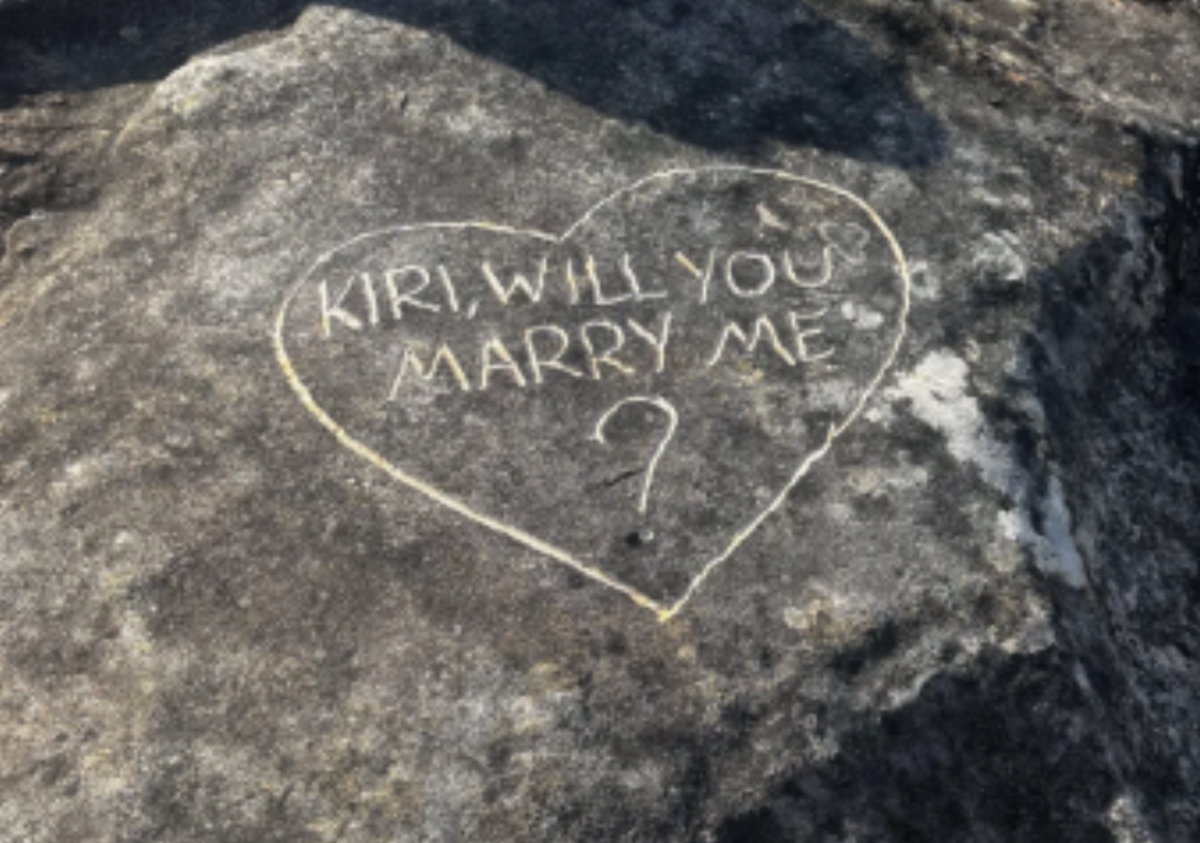
When it comes to romantic gestures, sometimes bigger isn't better.
A lovelorn graffiti artist has learned this the hard way after permanently etching a marriage proposal into ancient rock in one of Australia's most precious natural environments.
The vandalism occurred at a scenic lookout in the Blue Mountains, where someone carved a love heart into the rock face with the words 'Kiri, will you marry me?' The romantic gesture has backfired spectacularly, drawing fierce criticism from locals and potentially landing the culprit with eye-watering fines.
In this article
A location of global significance
What makes this act particularly troubling isn't just the vandalism itself, but where it occurred. The Greater Blue Mountains Area became a UNESCO World Heritage site in November 2000, joining the ranks of iconic locations like the Great Wall of China and the Pyramids of Egypt.
The Blue Mountains is one of only two cities in the world situated within a World Heritage Area—the other being Banff in Canada. This isn't just any pretty spot for a picnic; it's recognised as having 'outstanding universal value to humanity.'
National parks are to preserve. It's not preserving if everyone is allowed to actively change/alter what's there on a whim
Why the Blue Mountains earned World Heritage status
The area contains 91-101 species of eucalypts (13 per cent of the world's total)
More than 400 vertebrate species call it home
It provides significant representation of Australia's biodiversity with 10 per cent of the vascular flora
Includes rare species like the Wollemi Pine that have survived for millions of years
Sacred Country damaged
The vandalism becomes even more disturbing when you consider the cultural significance of the area. The Greater Blue Mountains has been inhabited by Aboriginal people for at least 12,000 years and overlaps the traditional Country of at least six indigenous language groups—the Wanaruah, Darkinjung, Darug, Wiradjuri, Gundungurra and Dharawal.
The area protects 700 known places of Aboriginal significance, with many others yet to be recorded. Important rock art and engravings can be found throughout the region, making any damage to rock faces potentially devastating to thousands of years of cultural heritage.
The eye-watering cost of 'romance'
While we don't know Kiri's response to the proposal, we do know the potential legal consequences are severe. Under NSW's National Parks and Wildlife Act 1974, substantial penalties apply for taking action that impacts World Heritage values without approval.
The original article noted that damaging Indigenous rock art carries potential penalties of up to $550,000 and 24 months imprisonment for individuals, with corporations facing fines of up to $1.1 million. Even if this particular rock face wasn't culturally significant, graffiti in national parks still carries heavy penalties under NSW vandalism laws.
Respectful ways to propose in nature
- Choose locations where photography is permitted and leave no trace
- Consider scenic lookouts in state forests or council reserves
- Hire a photographer to capture the moment instead of carving it permanently
- Plant a tree together in an appropriate location with council permission
- Create a memory book of your favourite shared outdoor experiences
Community fury reflects broader concerns
The harsh community response reflects growing frustration with social media-driven behaviour in natural spaces. Comments ranged from reasoned environmental arguments to blunt assessments like 'Dude. World Heritage. You're a w*****.'
One observer noted the irony: 'They clearly have a rocky relationship as it is.' Another took the long view: 'In 500 years some nerds are gonna be studying this for a PhD in historical graffiti.'
But beyond the quips lies genuine concern about the cumulative impact of such behaviour. Every carved initial, painted rock, and trampled area contributes to the slow degradation of places that took millions of years to form.
The 'leave no trace' principle
The high wilderness quality of much of the Greater Blue Mountains Area constitutes a vital contribution to its World Heritage value and has ensured the integrity of its ecosystems. This is why the 'leave no trace' principle exists—to ensure these precious environments remain unchanged for future generations.
NSW National Parks and Wildlife called the behaviour 'disappointing' and 'strongly discouraged,' urging visitors to leave areas as they found them. It's a simple request with profound implications for conservation.
Did you know?
Did you know? The Greater Blue Mountains area has survived ice ages, continental drift, and millions of years of natural change. The region contains ancient species like the Wollemi Pine, thought extinct until discovered in 1994 in a remote canyon.
When romance meets responsibility
There's something deeply ironic about trying to express love through an act that damages something beautiful. True romance might involve appreciating natural beauty without needing to claim ownership of it.
For couples wanting to commemorate special moments in nature, there are countless ways to do so without leaving permanent scars. Professional photography, memory books, or even planting trees in appropriate locations can create lasting memories without lasting damage.
What This Means For You
The Greater Blue Mountains area has survived ice ages, continental drift, and millions of years of natural change. It would be a tragedy if it couldn't survive human romance.
Whether Kiri said yes or no to this particular proposal, one thing is certain—the Blue Mountains deserves better than becoming a canvas for fleeting human emotions. These ancient landscapes have stories spanning millennia. They don't need our graffiti to tell them.
What's your take on this rocky romance? Have you witnessed inappropriate behaviour in our national parks? Share your thoughts and experiences in the comments below—we'd love to hear your perspective on protecting our precious natural heritage.
Original Article
https://7news.com.au/news/proposal-...ommunity-slamming-embarrassing-act-c-20139935
Greater Blue Mountains Area—Wikipedia
Cited text: The 1,032,649-hectare (2,551,730-acre) area was placed on the World Heritage List at the 24th Session of the World Heritage Committee, held in Cairns ...
Excerpt: The Greater Blue Mountains Area became a UNESCO World Heritage site in November 2000
https://en.wikipedia.org/wiki/Greater_Blue_Mountains_Area
Greater Blue Mountains World Heritage Listing
Cited text: The Greater Blue Mountains Area was inscribed on the World Heritage list on 29 November 2000 and is one of Australia's 19 World Heritage properti...
Excerpt: The Greater Blue Mountains Area became a UNESCO World Heritage site in November 2000
https://www.bluemts.com.au/info/about/world-heritage-listing/
About the World Heritage Anniversary | Blue Mountains City Council
Cited text: · As one of only two cities in the world situated within a World Heritage Area—the other being the picturesque town of Banff in Canada—the City of...
Excerpt: The Blue Mountains is one of only two cities in the world situated within a World Heritage Area
https://www.bmcc.nsw.gov.au/WHA/About
About the World Heritage Anniversary | Blue Mountains City Council
Cited text: The City of Blue Mountains is one of only two cities in the world surrounded by a UNESCO declared World Heritage National Park Area.
Excerpt: The Blue Mountains is one of only two cities in the world situated within a World Heritage Area
https://www.bmcc.nsw.gov.au/WHA/About
Greater Blue Mountains Area—UNESCO World Heritage Centre
Cited text: The site, comprised of eight protected areas, is noted for its representation of the evolutionary adaptation and diversification of the eucalypts in p...
Excerpt: The area contains 91-101 species of eucalypts (13 per cent of the world's total)
https://whc.unesco.org/en/list/917/
World Heritage places—Greater Blue Mountains Area—DCCEEW
Cited text: One hundred and one species of eucalypts (over 14 per cent of the global total) occur in the Greater Blue Mountains Area.
Excerpt: The area contains 91-101 species of eucalypts (13 per cent of the world's total)
https://www.dcceew.gov.au/parks-heritage/heritage/places/world/blue-mountains
Greater Blue Mountains world heritage area conservation | NSW Government
Cited text: More than 400 vertebrate species of native animals, including one third of Australia's bird species, have been recorded within the area.
Excerpt: more than 400 vertebrate species
https://www.nsw.gov.au/departments-...ht-greater-blue-mountains-world-heritage-area
Greater Blue Mountains Area—UNESCO World Heritage Centre
Cited text: The site provides significant representation of Australia's biodiversity with ten percent of the vascular flora as well as significant numbers of rare...
Excerpt: It provides significant representation of Australia's biodiversity with 10 per cent of the vascular flora, including rare species like the Wollemi Pine
https://whc.unesco.org/en/list/917/
The Greater Blue Mountains World Heritage Area Fast Facts
Cited text: is one of 17 World Heritage sites in Australia, and 851 in the world (in 2007) ... is made up of eight adjoining conservation reserves—Jenolan Karst...
Excerpt: The Greater Blue Mountains has been inhabited by Aboriginal people for at least 12,000 years and overlaps the traditional Country of at least six indigenous language groups
https://www.greaterbluemountainsdrive.com.au/world-heritage-area/fast-facts
Why are the Blue Mountains World Heritage Listed?
Cited text: The traditional owners of the areas of the Blue Mountains include six Aboriginal language groups, and important rock art and engravings can be found t...
Excerpt: Important rock art and engravings can be found throughout the region
https://bluemountainstoursydney.com.au/blog/why-are-the-blue-mountains-world-heritage-listed/
Greater Blue Mountains Area—UNESCO World Heritage Centre
Cited text: Substantial penalties apply for taking such an action without approval.
Excerpt: substantial penalties apply for taking action that impacts World Heritage values without approval
https://whc.unesco.org/en/list/917/
World Heritage places—Greater Blue Mountains Area—DCCEEW
Cited text: The high wilderness quality of much of the Greater Blue Mountains Area constitutes a vital and highly significant contribution to its World Heritage v...
Excerpt: The high wilderness quality of much of the Greater Blue Mountains Area constitutes a vital contribution to its World Heritage value and has ensured the integrity of its ecosystems
https://www.dcceew.gov.au/parks-heritage/heritage/places/world/blue-mountains







